Dataset1 -> Exons:
Start Length adjust_start end
1 1511150 724 723 1447
2 1518357 142 7930 8072
3 1520047 167 9620 9787
4 1520343 213 9916 10129
5 1520808 207 10381 10588
6 1523700 183 13273 13456
7 1523956 129 13529 13658
8 1524695 144 14268 14412
9 1524916 133 14489 14622
10 1525326 96 14899 14995
11 1526077 191 15650 15841
12 1526796 178 16369 16547
13 1558134 200 47707 47907
14 1562116 132 51689 51821
15 1564162 166 53735 53901
16 1566291 131 55864 55995
17 1568334 118 57907 58025
18 1571534 128 61107 61235
19 1580850 92 70423 70515
20 1583386 73 72959 73032
21 1584420 204 73993 74197
22 1586275 146 75848 75994
23 1587304 107 76877 76984
24 1588024 92 77597 77689
25 1589780 176 79353 79529
26 1592318 143 81891 82034
27 1592588 122 82161 82283
28 1602591 222 92164 92386
29 1607297 178 96870 97048
30 1610853 190 100426 100616
31 1612072 105 101645 101750
Dataset2 -> SNP:
V1
1 1586138
2 1602439
3 1523884
4 1592548
5 1602545
6 1571480
7 1526696
8 1571461
9 1583369
10 1592228
11 1584330
12 1526022
13 1526647
14 1523844
15 1562094
16 1557986
17 1586246
18 1583369
19 1564105
20 1583369
21 1584216
22 1584330
23 1580790
24 1523948
25 1519960
26 1525954
27 1520336
I am trying to plot this using the lollipop package of trackViewer (https://bioconductor.org/packages/release/bioc/vignettes/trackViewer/inst/doc/lollipopPlot.html)
At present I am using the the actual exons start and length:
features <- GRanges("chr1", IRanges(c(exons$Start), width=c(exons$Length), names=paste0("exons",1:31)))
And then plotting mutations against this:
sample.gr <- GRanges("chr1", IRanges(SNP, width=1,
## the name of GRanges object will be used as label
names=paste0("snp", SNP)),
## set the color for lollipop node.
color = sample.int(10, length(SNP), replace = TRUE),
## set the lollipop stem color
border = sample(c("black", "gray80", "gray30"),
length(SNP), replace=TRUE)
)
features$fill <- c("lightblue")
## define the feature heights
features$height <- c(.1)
## lollipop plot
lolliplot(sample.gr,
features)
Giving me:
This is really compressed. I really just want to plot the exons and the mutations ignoring the white space between them.
However, as you can see from the Exons dataset I have tried to create an "adjusted_start" and end where I have subtracted the total length of the gene (1510427). I then want to plot them end to end but also adjust the SNP dataset by the amount of adjustment made to the first table so that it all fits together. Below is an example diagram done very crudely:
Any help would be much appreciated.

